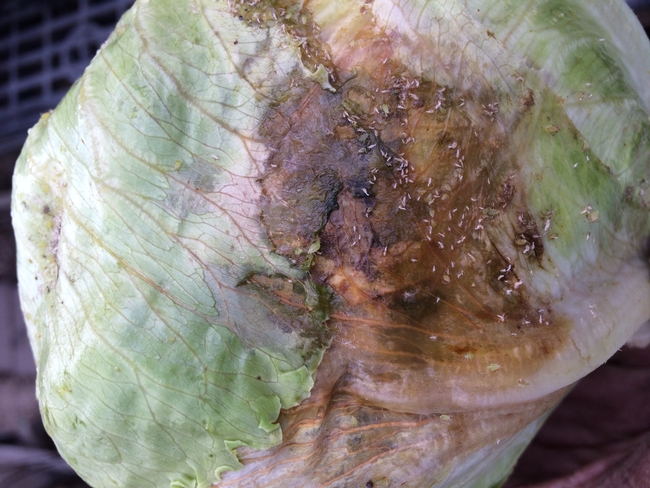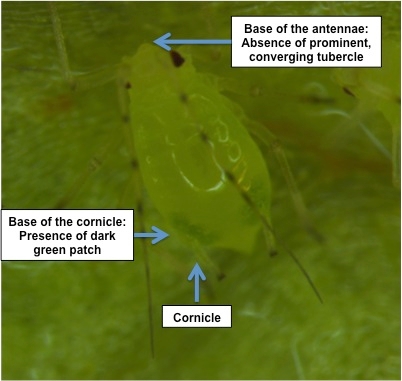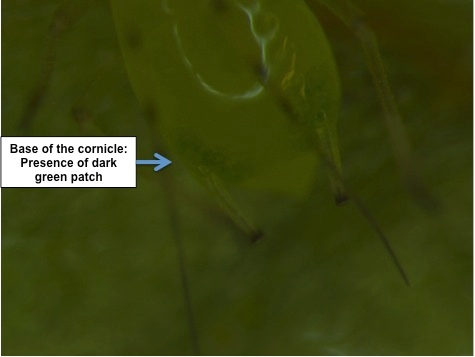Aug 17, 2014
Recently, a widespread outbreak of foxglove aphid (Aulacorthum solani) (Figures 1, 2 and 3) has been reported in the Salinas Valley. Reports were primarily from Salinas to Soledad at this point. Growers have been losing several acres of lettuce to foxglove aphid since last one and half months.
Foxglove aphid nymphs and wingless adults have a light to dark green patch at the base of the cornicle (Figures 4 and 5). The lettuce aphids (Nasonovia ribis-nigri) do not have any patch at the base of the cornicle. Cornicle is a tube-like organ at the back of the aphid as shown in the figures 4 and 5. The foxglove aphids observed were yellowish to green in color than pink or red. At the base of the antennae, foxglove aphid doesn't have any prominent converging tubercles (a projecting structure), which is typical for green peach aphid (Myzus persicae). The joins of legs and antennae of foxglove aphid are darker (dusky) than other regions. Winged adults of foxglove aphid and lettuce aphid are practically indistinguishable from each other.
Generally, aphids are capable of reproducing parthenogenetically meaning female aphids lay eggs without mating and all the eggs turn into females. Moreover, in warmer conditions like in summer, they pretty much give birth to young ones as the eggs hatch within the reproductive canal of the female. Typically, a single aphid give birth to about 50 to 100 nymphs in two weeks or about 10 nymphs every day, which could vary with environmental conditions such as temperature and humidity. Foxglove aphids can complete a generation in less than 2 weeks in the summer. Unlike lettuce aphid, foxglove aphid has a broad host range meaning it could survive on several host plants.
Detection of foxglove aphid early in the crop stage is critical. They initially infest the cap or outer leaves of head lettuce. Eventually, foxglove aphids move into the deeper layers of leaves then form colonies. Green peach aphids on the other hand, form colonies on the wrapper leaves from the onset. Based on anecdotal observations, foxglove aphid colonies have been observed in lettuce about 20 days to harvest. The lettuce crops during thinning stage often appeared clean (without foxglove aphids).
Management of foxglove aphid with insecticides has been monitored more closely than ever before. It is important to note that spirotetramat (Movento), which is widely used against aphids has to metabolize from applied form (spirotetramat) and convert into more toxic derivatives within the plant in order to be toxic or effective against aphids. Normally, it will take at least 10 days for this metabolic process and movement of derivatives into the growing tissues of the lettuce. Thus, two applications of spirotetramat (5 fl oz/acre each) should be timed at the onset of first foxglove infestation without delay. Late application of spirotetramat (e.g. 10 days before harvest) may not offer any control. Also, it is important to keep in mind that there is little use if the applications are made when high populations of foxglove aphid have been detected. Make sure that the insecticides such as acetamiprid (Assail), imidacloprid, thiamethoxam (Actara) are used in rotation. Back-to-back use of insecticides in same class or IRAC group (http://www.irac-online.org/teams/mode-of-action/) will increase the risk of development of aphid resistance to a particular class of insecticides. Once a super aphid has been created, there is no value in using insecticides from that class to manage aphids. The industry is currently seeking emergency registration of sulfoxaflor (Closer or Sequoia) for use to tackle foxglove aphid problem this season. Sulfoxaflor is systemic (moves within the plant), trans-laminar (move through leaves) and acts in hours once applied and is from a new insecticide class or IRAC group. Please email (Shimat Joseph: svjoseph@ucanr.edu) or call (831) 229 8589 if you have further questions.
 Figure 1. Foxglove aphid infested head lettuce
Figure 1. Foxglove aphid infested head lettuce Figure 2. Foxglove aphid infested head lettuce
Figure 2. Foxglove aphid infested head lettuce Figure 3. Foxglove aphids
Figure 3. Foxglove aphids Figure 4. Diagnostic character of foxglove aphid
Figure 4. Diagnostic character of foxglove aphid Figure 5. Diagnostic character of foxglove aphid
Figure 5. Diagnostic character of foxglove aphid
Topics: